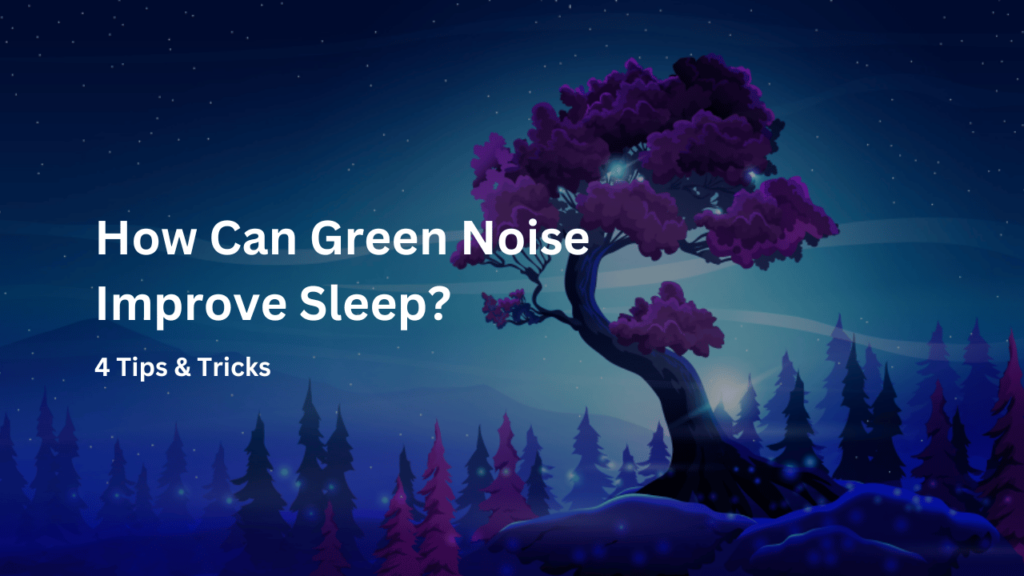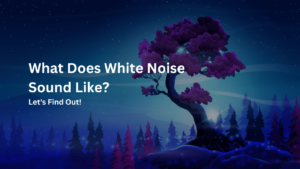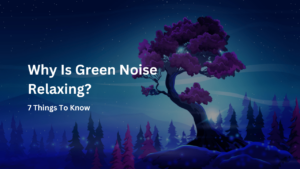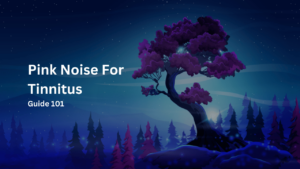Green noise is an emerging trend in sound therapy that can help improve sleep quality.
As our world gets busier and noisier, finding ways to unwind and get better rest is becoming increasingly important.
Green noise offers a calming, natural soundscape that may provide real benefits for sleep.

What is Green Noise?
Green noise gets its name from the analogy to white noise and pink noise. While white noise contains a flat spectrum of frequencies and pink noise decreases in volume across frequencies, green noise has more emphasis on mid-range frequencies.
It’s designed to mimic the gentle rustling sounds of leaves in the breeze or a babbling brook. The sound has a fuzzy, textured quality unlike harsh mechanical white noise.

How Can It Improve Your Sleep?
Our brains instinctively respond to the steady, soothing cadence of green noise. It induces slow brain wave activity, shifting the mind and body into a relaxed state.
Research shows sound environments can have a powerful impact on stress hormones, heart rate, memory, and sleep.
Green noise provides a peaceful backdrop that distracts the mind from racing thoughts and tunes out a noisy environment.
1. Masking Disruptive Noises
One of the biggest benefits of green noise is its ability to mask unwanted sounds. The ambient texture forms an acoustic barrier between you and noisy neighbors, traffic, snoring partners etc.
This masking effect helps to mute sudden changes or spikes in volume that can disrupt light sleep. The brain isn’t having to process as many distracting auditory signals.
2. Reducing Brain Hyperactivity
The slow amplitude modulations of green noise act like a volume knob, turning down excitability in the auditory cortex.
Areas of the brain tied to reward, emotions and cravings become less stimulated. Research shows that green noise recordings activate calming theta and delta brain waves. Slow wave activity is a marker of deep, restorative sleep.
3. Lowering Stress Hormones
Relaxing sound environments have been found to reduce release of the stress hormone cortisol. Elevated cortisol harms sleep quality because it amps up alertness.
Green noise’s natural, flowing quality may decrease worry and rumination before bed. The predictable sound patterns send signals to your nervous system that everything is A-OK, making it easier to unwind.

4. Improving Sleep Quality
Studies indicate that green noise can lead to faster sleep onset, fewer nightly awakenings, more time spent in deep sleep and higher quality sleep ratings.
Subjects exposed to green noise overnight spent more time in the restorative stages of non-REM sleep. Memories and cognitive function rely on adequate slow wave sleep.
Who May Benefit Most?
Green noise may hold promise for those who struggle with:
- Insomnia: Especially middle of the night or early morning awakenings. The soundscape helps block out disruptions.
- Light sleepers: Easily disturbed by noises inside and outside the home. Creates a masking effect for irritating sounds.
- Anxious thoughts: Redirects focus to a calming sound environment. Lowers stress hormone levels.
- Tinnitus: Provides an alternate sound source to distract from ringing or buzzing. Masks the phantom noise perception.
- Sensory disorders: Like autism. Sound therapies may improve sleep by reducing hypersensitivity.
- Dementia: Gentle, natural sounds can ease agitation and restlessness. Familiar environments are soothing.
Practical Tips for Using Green Noise to Improve Sleep
Incorporating green noise into your sleep routine can be a simple yet effective way to enhance sleep quality. Here are some practical tips for getting started:
- Use a Sound Machine or App: Many sound machines and smartphone apps offer a range of natural sounds, including those categorised as green noise. Experiment with different sounds to find the one that’s most relaxing for you.
- Create a Pre-Sleep Ritual: Incorporate green noise into a pre-sleep ritual that promotes relaxation. This could involve dimming the lights, practicing deep breathing or meditation, and then playing green noise as you prepare to sleep.
- Adjust Volume Appropriately: The volume should be loud enough to mask disruptive noises but not so loud that it becomes disruptive itself. A moderate volume level that blends into the background is ideal.
- Consistency is Key: Use green noise consistently as part of your nightly routine. Over time, your brain will associate these sounds with sleep, making it easier to drift off each night.
- Combine with Other Sleep Hygiene Practices: For the best results, combine green noise with other sleep hygiene practices, such as maintaining a regular sleep schedule, ensuring your bedroom is comfortable and dark, and avoiding screens before bedtime.
Give Green Noise a Try
Green noise offers a non-invasive way to retreat into a peaceful sound environment. Flowing, textured soundscapes mimic nature’s calming nocturnal rhythms.
If you struggle with insomnia or an overstimulated mind at bedtime, green noise may help mute disruptions, reduce brain hyperactivity and pave the way for better sleep.
With little downside, it’s worth playing green noise to see if it makes a difference in your ability to unwind and recharge at night.
Frequently Asked Questions (FAQs)
Ques 1: What color noise is best for sleeping?
Ans: Pink and brown noise tend to be best for aiding sleep since they have soothing, relatively minimal higher frequency content compared to white noise.
Ques 2: What is the best sound to fall asleep to?
Ans: Gentle, consistent background noise like rainfall, light music, or low volume pink or brown noise work well for many people trying to fall asleep faster.
Ques 3: What are the benefits of green noise?
Ans: Reported benefits include increased relaxation, focus and productivity as well as masking unpleasant sounds to help with sleep or tinnitus symptoms.
Ques 4: What does green noise do to your brain?
Ans: There is still limited research, but some evidence suggests green noise enhances alpha brain waves tied to wakeful relaxation and limits over stimulating activity.
Ques 5: What noise puts you to sleep the fastest?
Ans: Gentle white noise or frequency-focused noises like pink or brown noise tend to aid falling asleep fastest due to consistencies masking disruptive sounds.



